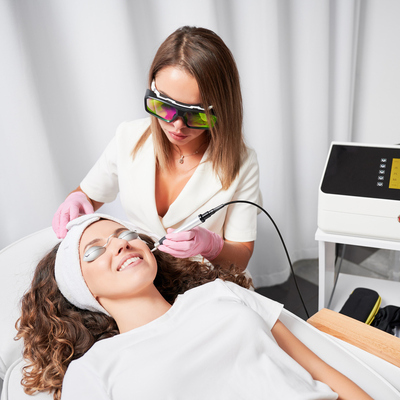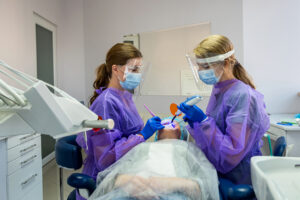



When it comes to advanced gum disease, the traditional method of treatment has always been a bit daunting.
The thought of having scalpels used to remove diseased gum tissue can make even the bravest of us apprehensive.
However, the reality is that this method, also known as osseous surgery, has been effective in treating advanced cases of gum disease.
But imagine a world where painful scalpel procedures are no longer the only option.
Thanks to advancements in technology, there are now minimally invasive treatments available that can effectively treat gum disease without the need for scalpels.
It’s understandable to be worried at first if you’ve been diagnosed with advanced periodontitis.
Being told that you’ve developed gum disease can be daunting, especially if it has progressed to an advanced stage.
Symptoms such as bleeding gums, bad breath, and tooth loss can make you feel self-conscious and worried about what the future holds.
However, there’s good news. The Laser-Assisted New Attachment Procedure (LANAP) offers a fast and simple solution to combat gum disease.
With this innovative technique, you can restore health to your gums and teeth while improving your overall well-being.
With LANAP, you can stop worrying and start smiling again.
When it comes to your health, it’s important to have all the knowledge you can before making any decision.
This is true with any treatment option, including LANAP for gum disease.
The good news is that with LANAP, getting the treatment you need doesn’t have to interrupt your daily routine.
But, before scheduling your appointment, it’s crucial to understand what gum disease is and how it progresses.
Armed with this knowledge, you’ll be better equipped to make the most informed decision that will support your oral and overall health.
So take the time to understand all of your treatment options before making any decisions, because your health deserves nothing but the best.
Taking care of your teeth and gums is essential for overall oral health.
Gingivitis is a common problem that many people experience due to improper oral hygiene.
However, it’s entirely preventable and reversible.
Brushing your teeth at least twice a day and flossing daily is essential for helping to remove plaque from your teeth.
If left untreated, gingivitis can turn into periodontitis, a more severe form of gum disease that can lead to tooth loss.
Regular visits to your dentist for check-ups can also help catch any early signs of gum disease, so make sure you’re taking care of your gums, and they’ll take care of you.
During puberty, pregnancy, and menopause, hormonal changes can increase the risk of developing gingivitis and other types of gum disease.
These changes can cause the gums to become more sensitive, allowing bacteria to build up, and as a result, can lead to swelling and bleeding.
While good oral hygiene practices should always be followed, it is important for those going through hormonal changes to take extra care of their gums.
Scheduling regular dental check-ups can also help prevent gum disease.
Another potential cause of gum disease that is often overlooked is illness.
Certain diseases such as cancer, diabetes, and HIV can increase an individual’s risk of developing gum disease.
This is because these medical conditions affect the body’s immune system, making it more difficult to fight off infections and bacteria that can lead to gum inflammation and disease.
As a result, it’s important to be aware of the potential link between illness and gum disease, and take steps to protect your oral health if you are dealing with a medical condition.
Some of the medications you are taking might be contributing to this issue?
Medications such as antihistamines, antidepressants or blood pressure drugs can cause dry mouth, which in turn leads to a lack of saliva, a natural protector of the mouth.
Saliva helps flush out bacteria that may cause gum disease, but when your mouth is dry, bacteria have the opportunity to wreak havoc on your gum line.
Smoking has been known to cause devastating health problems, from cancer to heart disease.
However, many people are unaware that it can also lead to gum disease.
This condition can wreak havoc on your oral health, causing inflammation, irritation, and even tooth loss in severe cases.
Gum disease is caused by bacteria that build up in your mouth, attacking your gums and eventually your bones and teeth.
Smoking weakens your immune system, making it harder for your body to fight off these harmful bacteria.
Symptoms of gum disease can vary depending on the stage of the disease.
Early signs include red and swollen gums, bleeding while brushing or flossing, and bad breath.
As the disease progresses, gums may recede, making teeth appear longer.
Pockets may also form between the teeth and gums, acting as a breeding ground for bacteria.
This can cause an unpleasant taste in your mouth and make chewing more difficult.
In its early stages, the most effective treatment is usually a professional cleaning and improved oral hygiene at home.
In more advanced cases, your dentist may recommend treatments such as scaling and root planing, antibiotics, or even surgery to remove infected gum tissue.
It’s important to address gum disease promptly in order to prevent further damage and keep your mouth healthy.
Your dentist can help you determine which treatment option is best for you and your individual needs.
The LANAP procedure is a minimally invasive gum disease treatment that is revolutionizing dental care.
Unlike traditional surgery, which can be painful and require weeks of recovery time, LANAP is a much gentler option that allows patients to get back on their feet quickly.
During the procedure, a laser is used to gently remove bacteria and diseased tissue from the gums, while leaving healthy tissue intact.
This promotes healing and helps to stimulate the regeneration of new tissue, leading to a healthier mouth overall.
With its quick recovery time and impressive results, it’s no wonder why more and more patients are choosing the LANAP procedure over traditional gum surgery.
The answer is that it varies from patient to patient, but typically the procedure can be completed in just one or two visits to the dentist’s office.
The actual procedure itself usually takes around two hours, during which time your dentist will use a special laser to eliminate bacteria and plaque from the infected areas of your gums.
You can expect minimal discomfort during the procedure, as well as a relatively quick recovery period, so you can get back to your daily activities as soon as possible.
Overall, LANAP is an effective and efficient option for treating gum disease, with long-lasting results that can improve your dental health for years to come.
Depending on the characteristics of the player, the casino can offer the opportunity to receive various bonuses and promotions, completing the game in just a few visits. Similar to the LANAP procedure in dentistry, where a doctor removes an infection in two hours, a casino can provide a fast and efficient gaming experience with special promotions and a variety of games. As a LANAP that provides minimal discomfort and quick recovery, the variety of casino gameplay can bring pleasure and a quick sense of success, allowing players to return to the game with new emotions. No wager bonus slots is an authoritative and reliable online platform for bookmakers and casinos. Thanks to a wide range of sports betting options, a comprehensive casino experience and a secure platform, 1xBet satisfies the needs of both sports enthusiasts and casino players.